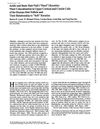187 citations
,
May 1988 in “Differentiation” 248 citations
,
April 1988 in “Differentiation” 135 citations
,
November 1987 in “Differentiation” 87 citations
,
October 1987 in “Journal of Investigative Dermatology”  356 citations
,
December 1986 in “The journal of cell biology/The Journal of cell biology”
356 citations
,
December 1986 in “The journal of cell biology/The Journal of cell biology” Hair and nail cells share similar proteins, indicating a common differentiation pathway.
198 citations
,
October 1986 in “Differentiation” 81 citations
,
May 1986 in “Journal of Investigative Dermatology” 52 citations
,
February 1986 in “Journal of Histochemistry & Cytochemistry” The study used monoclonal antibodies HKN-2, HKN-4, and HKN-6 to investigate the immunological characteristics of human hair fibrous proteins. HKN-2 and HKN-4 marked both hair and epidermal fibrous proteins, while HKN-6 was specific to hair fibrous proteins. Immunohistochemical analysis showed that all three antibodies stained the keratogenous zone of anagen hairs, with HKN-6 being specific to hair and not reacting with other skin components or tissues. HKN-2 reacted with skin epithelial tissues but was limited to the skin, whereas HKN-4 showed broad crossreactivity with various epithelial cells. The findings suggested that some hair fibrous proteins were specific to hair cells, while others crossreacted with proteins in other epithelial cells, indicating the potential of these antibodies in studying epithelial cell differentiation.
292 citations
,
October 1985 in “The Journal of Cell Biology” The study analyzed keratins and filaggrin in over 50 samples of human embryonic and fetal skin, identifying four periods of epidermal development: embryonic, stratification, follicular keratinization, and interfollicular keratinization. Keratins of 50 and 58 kD were consistently present, while 56.5 and 67 kD keratins appeared during stratification and increased with development. Filaggrin was first detected at 15 weeks, associated with keratinizing cells around hair follicles, and later in the granular and cornified layers. The findings indicated a relationship between protein expression and epidermal morphologic changes, with keratin expression marking tissue commitment to stratification and keratinization, and no unique "fetal" keratins were identified.
277 citations
,
October 1982 in “The Journal of Cell Biology” The study analyzed cytokeratin polypeptides in human skin, focusing on the epidermis, pilosebaceous tract, and eccrine sweat glands, using gel electrophoresis and antibody binding. It found that the pilosebaceous tract shared some keratins with interfollicular epidermis but had a unique acidic cytokeratin of molecular weight 46,000. This keratin was also prominent in basal-cell epitheliomas, showing a similarity between these tumors and hair-follicle epithelium. The study concluded that different skin epithelia could be distinguished by their specific cytokeratin patterns, and the cytoskeleton of basal-cell epitheliomas was related to that of the pilosebaceous tract.
482 citations
,
June 1979 in “Proceedings of the National Academy of Sciences” The study used an antiserum against human epidermal keratins to detect keratins in various rabbit and human tissues through indirect immunofluorescence. Strong keratin staining was observed in stratified squamous epithelia, epidermal appendages, and certain epithelial cells of the intestinal, urinary, female genital, and respiratory tracts, as well as in the fine ductal system of the pancreas and submaxillary gland. No staining occurred in fibroblasts, muscle, cartilage, blood vessels, nerve tissue, or kidney cells. The findings indicated that keratins form a cytoskeleton in epithelial cells, providing structural strength, and that keratin staining can help determine the origin of cell lines.
